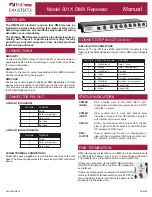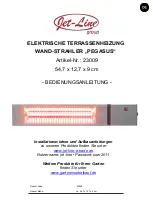
5
I-RIH (05-21) 131793-A
Installation Codes
•
These units must be installed in accordance with local building codes . In the absence of local codes, in the U .S .,
the unit must be installed in accordance with the National Fuel Gas Code ANSI Z223 .1/NFPA 54 (latest edition) . A
Canadian installation must be in accordance with the CAN/CSA B149 .1,
Natural Gas and Propane Installation Code
.
These codes are available from CSA Information Services, 1-800-463-6727 . Local authorities having jurisdiction
should be consulted before installation is made to verify local codes and installation procedure requirements .
•
All electrical wiring including electrical grounding must be in accordance with the National Electric Code ANSI/
NFPA No . 70 (latest edition) or, in Canada, the Canadian Electrical Code, Part I and Part II, CAN/CSA C22 .1 .
•
The installing contractor must be familiar with all of the various requirements and is responsible for installing the
heater in compliance with the applicable codes .
• Aircraft hangars:
•
In the U .S ., the heaters must be installed in accordance with ANSI/NFPA 409 (latest edition) . Publications are
available from the National Fire Protection Association, Batterymarch Park, Quincy, MA 02269 . In Canada,
installations in an aircraft hangar must comply with CAN/CSA-B149 .1 . Both the ANSI/NFPA 409 (latest edition)
and the CAN/CSA-B149 .1 (latest edition) specify that the heater shall not be located in an area of an aircraft
hangar where it may be subjected to physical damage by aircraft, cranes, moveable scaffolding, or other objects .
•
NFPA 409 (latest edition) specifies a clearance of 10 feet (3 meters) to the bottom of the heater from the highest
surface of the wings or engine enclosures of the highest aircraft which may be housed in the hangar . The
measurement shall be made from the wing or engine enclosure, whichever is higher from the floor, to the bottom
of the heater .
•
CAN/CSA-B149 .1 (latest edition) specifies that a heater located in an aircraft storage or servicing area shall be
installed so that no portion of an aircraft that can occupy the area is within the
clearance to combustible material
,
as marked on the heater rating plate .
•
Both NFPA 409 (latest edition) and CAN/CSA-B149 .1 (latest edition) specify a minimum clearance of 8 feet (2 .5
meters) from the floor to the heater in other sections, such as offices or shops, that communicate with the aircraft
hangar .
• U.S. repair garages:
•
In the U .S ., heaters installed in public garages must be in accordance with the
Standard for Motor Fuel Dispensing
Facilities and Repair Garages
, NFPA 30A (latest edition, formerly the
Standard for Repair Garages
, NFPA 88B) .
•
Heat-producing appliances using gas or oil fuel listed for use in garages shall be permitted to be installed in
lubrication rooms, service rooms, or fuel dispensing ares where class I liquids are dispensed or transferred,
provided the equipment is installed at least 8 feet (2 .5 meters) above the floor .
• U.S. parking structures:
•
In the U .S ., these overhead heaters are suitable for use in parking structures when installed in accordance with
the
Standard for Parking Structures
, NFPA 88A (latest edition) .
•
All flames associated with the heating equipment shall be located a minimum of 18 inches (500 mm) below the
floor-ceiling assembly or 18 inches (500 mm) above the floor .
• Canada garages:
•
In Canada, these overhead heaters are suitable for use in garages when installed in accordance with the
Canadian
Natural Gas and Propane Installation Code
,CAN/CSA B149 .1 (latest edition) .
•
The minimum clearance from the radiant face of the infrared heater to the upper surface of the highest vehicle
shall not be less than the certified clearance from combustible material as indicated on the heater (installed in a
garage or a car wash) . Provision shall be made to maintain these minimum specified clearances by an interlock
that shuts off the gas supply until the required clearances have been re-established, a protective bar, or a device
that provides a warning when the clearances are not being maintained . Where an infrared heater is installed in
a garage and the clearance from combustible material cannot be maintained when the vehicle is raised on a
hoist, an electrical interlock shall be provided to shut off the burner and prevent its operation until the required
clearance has been re-established .






































